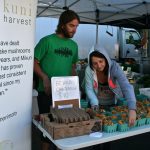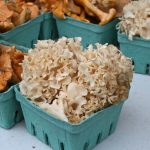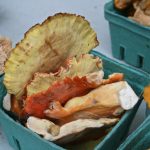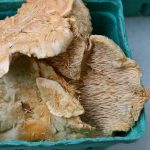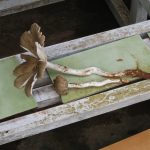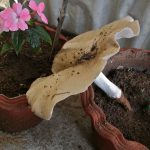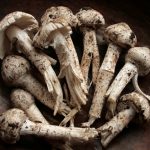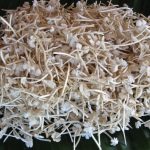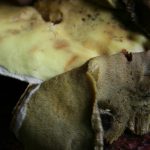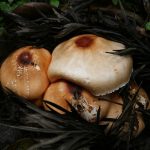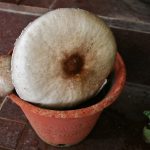Two wild mushroom seasons to savour – a monsoon one in Coorg and an autumn one in British Columbia. Each throws up wild fungi with distinct personalities, forged by the terroir, no doubt.
British Columbia is a mycologists’s dream, with thousands of species lurking about, waiting to be discovered. And for someone who just loves to eat wild mushrooms, this is paradise, and not just in the fall. The climate here allows for a wide span of foraging and harvesting months. At this time of year, the Queen Charlotte islands sprout fields of golden chantrelles that can be seen from the air. Northwest B.C. is where the precious Pine mushrooms, or matsutake grow. Their distinctive, resinous fragrance is quite beautiful. Sweet tooth or hedgehog mushrooms, cauliflower mushrooms, chicken of the woods, wild oyster mushrooms, lion’s mane.. it’s a deliciously jumbled jungle out there!
The hilly region known as the Western Ghats in India, too, is host to large variety of edible fungi, though they are rather harder to come by these days. The use of chemical fertilizers and the increasing pressure of population on the land has reduced the grounds where mushrooms can grow undisturbed, So, if you are lucky enough to get some, savour every morsel.
Only a trained eye can distinguish edible mushrooms from poisonous ones. Under no circumstances should anyone without experience attempt to pick and eat wild mushrooms without expert supervision.
Wild mushrooms are possibly the most delicious of the seasonal treats the monsoon turns up in Coorg . Mixed in with the nervousness brought on by the ominous rumbling of thunder and blinding cracks of lightning, is the thrill of anticipation of a good haul of mushrooms.”Good mushroom weather!” someone is bound to say, while casting a nervous glance at the sky.
There are several commonly known edible varieties in Coorg, ranging from the feathery, delicate nucchi kummu, and kokkalé kummu, succulent aal kummu, to the giant nethalé kummu, which can quite easily grow to 1 1/2 feet high or more. There are other edible ones besides these, but force of habit can be hard to overcome, and the decidedly meaty Bolete, pandi kummu, finds few takers among those raised on a diet of the former kinds.
When I go out foraging during the monsoon, I always make sure to cross check what mushrooms I have picked with people whose knowledge I can trust.One mushroom I brought home was identified as “paal kummu” (milk mushroom) and declared edible. My mother vetoed the eating of it, declaring it might actually have been another, very similar word I’d heard, which means ‘bad” or ‘spoiled’! The mushroom disappeared. I bet it was tasty.
These wild mushrooms hold a scent of rain-soaked earth and an essence of forest that is hard to forget. Rather like the thunder and lightning of a Coorg monsoon!
Kummu curry
A simple curry that allows the flavour of wild mushrooms to shine through.
- 1/2 kg mushrooms, cleaned and sliced ( oyster mushrooms and crimini work well here )
- 2 medium onions, finely sliced
- 3 – 4 green chillis ,slit
- 1 tsp coriander powder
- ½ tsp turmeric powder
- ½ tsp red chilli powder
- 2 tbsp oil
- ½ tsp mustard seeds
- 2 tbsp lime juice
- Salt to taste
Grind together to a smooth paste:
- 1 cup grated coconut
- ½ tsp cumin, lightly roasted and powdered
Heat the oil in a deep pan, kadhai or wok and put in the mustard. When it sputters, add the onions and green chillis. Fry until the onions are soft and just beginning to brown. Add the mushrooms along with the remaining spices. Sauté briefly, then add one cup of hot water and salt to taste. Simmer for five minutes, then add the ground coconut and cumin. Cook on low for two more minutes. Remove from heat and add lime juice.
If you don’t have wild mushrooms, here are a couple of ways to make even dull supermarket mushrooms take a walk on the wild side.
- Drying mushrooms intensifies their flavour and can be done quite easily at home. A friend remembers her grandmother stringing mushrooms on lengths of twine and hanging them to dry above the wood stove in her kitchen in rural Coorg. They had the added cachet of being smoked too!Slice button mushrooms thinly and separate oyster mushrooms into 1 – 2” clumps. Dry in the oven on very low heat or in the direct sun until they are darkened,shriveled and leathery. Store in airtight containers. Soak them in hot water to rehydrate. Use these dried mushrooms and their soaking liquid to make your curry and see if it doesn’t taste just that much better.
- Chutta kummu (roasted mushrooms)
A favorite snack of my maternal grandfather, a lucky treat for any child who happened to be hanging about him at the right time!There were times when the land below the hedgerows in the field behind my grandparents’ home would turn white with a carpet of mostly edible mushrooms. One of my fondest memories is of scrambling up the muddy slope to gather them in the company of a young maid who knew which ones were safe to pick. The early morning chill and soaking grass just whetted the appetite for Akki ottis and kummu curry which were certainly on the menu on those days!This is the most delicious way I know of preparing a freshly picked, wild mushroom.Slice nethale kummu or oyster mushrooms into large pieces. Have ready some lime wedges and a little freshly roasted and coarsely ground chilli powder with a little salt mixed in. A not too hot variety of chilli like byadgi would be good. Pick up the pieces of mushroom with tongs and roast very briefly on hot coals or an open flame. Working fast, singe all the pieces and sprinkle over quickly with a little chilli powder, salt and a good squeeze of lime. Eat immediately. Mop up any juices with a slice of bread or akki otti.

